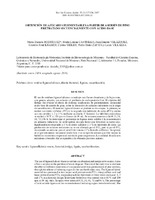Obtención de azúcares fermentables a partir de aserrín de pino pretratado secuencialmente con ácido-base
Date
2017-05-22Author
Rodríguez, María Daniela
Castrillo, María Lorena
Velázquez, Juan Ernesto
Kramer, Gustavo Raúl
Sedler, Cyntia Ingeborg
Zapata, Pedro Darío
Villalba, Laura Lidia
Metadata
Show full item recordAbstract
El uso de residuos lignocelulósicos constituye una fuente abundante y de bajo costo, que genera, además, una solución al problema de su disposición final. El objetivo del trabajo fue evaluar el efecto de distintas condiciones de pretratamiento secuencial ácido-base de aserrín de pino, sobre la liberación de azúcares reductores en la etapa de sacarificación. El material lignocelulósico se pretrató en dos etapas: la primera, se realizó con ácido sulfúrico (PT1) y la segunda con hidróxido de sodio (PT2), ambas con tres niveles: 1, 2 y 3 % mediante un diseño 32 factorial. La hidrólisis enzimática se realizó a 50 ºC y 150 rpm en frascos de 50 mL. Se tomaron muestras a las 0.15, 24, 48, 72 y 96 h. Se determinó el porcentaje de lignina ácido soluble (% ASL) y la concentración de azúcares reductores. El nivel óptimo de cada factor que favoreció la mayor deslignificación correspondió a 3 % de ácido sulfúrico y 3 % de hidróxido de sodio. La producción de azúcares reductores no se vio afectada por el PT2, pero si por el PT1, alcanzando un máximo para el nivel 0 del mismo (2 % de ácido sulfúrico). Se optimizó el pretratamiento secuencial ácido-base y se comprobó además que éste mejora la hidrólisis enzimática con respecto al aserrín de pino sin pretratar. La cantidad de azúcares reductores obtenidos fue comparable a la obtenida por otros autores. The use of lignocellulosic waste constitutes an abundant and inexpensive source; it also offers a solution to the problem of waste disposal. The aim of the study was to evaluate the effect of different conditions of a sequential acid-base pretreatment of pine sawdust, through the release of reducing sugars in the saccharification step. The lignocellulosic material was pretreated in two stages: acid pretreatment (PT1), using sulfuric acid and basic pretreatment (PT2), employing sodium hydroxide at three levels each one: 1, 2 and 3 % in a factorial design. Enzymatic hydrolysis was carried out at 50 ºC and 150 rpm in 50 mL vials. Samples were taken at 0.15, 24, 48, 72 and 96 h. The percentage of acid soluble lignin and the concentration of reducing sugars were determined. The optimum level of each factor favoring the highest delignification corresponded to 3 % sulfuric acid and 3 % sodium hydroxide. The production of reducing sugars was not affected by the PT2, but by the PT1, achieving a maximum for level 0 thereof (2 % of sulfuric acid). The sequential acid-base pretreatment was optimized and it was found that this pretreatment improves enzymatic hydrolysis of pine sawdust respect to unpretreated samples. The amount of reducing sugars obtained was comparable to that obtained by other authors.
Collections
The following license files are associated with this item:




